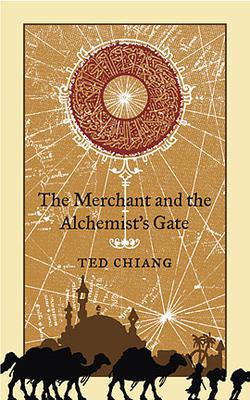The Merchant, the Portal, and Time Loops: Science and Fiction in Ted Chiang
20 Junho 2025
Escrito por Francisco H. C. FelixIn his award-winning short story “The Merchant and the Alchemist’s Gate,” Ted Chiang weaves a fascinating narrative around a real scientific concept: closed timelike curves. Closed timelike curve: A trajectory in spacetime that returns to the same point, theoretically allowing time travel without violating general relativity. Inspired by a lecture from physicist Kip Thorne, Chiang explores the idea of trajectories in spacetime that return to the same point—meaning, mathematically possible time travel.

Cover of the original edition of “The Merchant and the Alchemist’s Gate”. Image by Subterranean Press, published on Wikimedia Commons under Creative Commons Attribution 3.0 Unported license.
Before we get lost in paradoxes and portals, it’s worth asking: what is time, after all? Long before time became a theme in Western philosophy, Hindus wrote in the Vedas about cycles of creation and destruction lasting more than 4 million years each. The Egyptian Ptahotep said that wasting time was an abomination (perhaps already anticipating Novikov? - see below). The Incas saw space and time as one: pacha. And probably the ancient speakers of Proto-Semitic already had the concept of remote time and an origin of time.
For Aristotle, time was not an independent entity, but the measure of change—time exists only because things change. Newton, on the other hand, saw time (and space) as absolutes, a fixed stage where everything happens, regardless of what exists or changes. Then Einstein brought the big surprise: time can “stretch” or “shrink” depending on speed and gravity, becoming relative to the observer. Relativity: The physical theory developed by Einstein that revolutionized our understanding of space, time, and gravity, showing they are relative to the observer. Other philosophers also gave their interpretations, but none changed our understanding as much as modern physics.
But what are these curves, after all? Technically, they are “closed worldlines of a Lorentzian manifold in spacetime.” In simpler terms: they are trajectories that allow an object to return to the same point in space and time. The first mathematical solution for this concept was found by Willem Jacob van Stockum in 1937, and later confirmed by Kurt Gödel in 1949, both using Einstein’s field equations.
Even before time travel was seriously considered, Karl Schwarzschild—adventurer, mountaineer, and physicist—found the first exact solution to Einstein’s equations during World War I. Wormhole: A theoretical solution to Einstein’s equations connecting two distinct points in spacetime, acting as a cosmic shortcut. His work paved the way for the concept of wormholes, which would later be considered possible mechanisms for closed timelike curves. If anyone had to be a time traveler, it would be him.
One of the concepts that most fascinated Chiang was Novikov’s self-consistency principle. But who was Novikov? Igor Dmitriyevich Novikov is a Russian astrophysicist and cosmologist, known for his contributions to black hole physics, cosmology, and especially to the study of time travel. Novikov self-consistency principle: States that events causing time paradoxes have zero probability of occurring, making the universe “self-consistent”. He formulated the self-consistency principle, which states that the probability of worldlines causing time paradoxes is zero. In other words, the universe “adjusts itself” to prevent paradoxes, making them impossible.
In the 1990s, Thorne and other physicists found mathematical solutions suggesting the existence of infinite closed timelike curves that avoid paradoxes. Time paradox: A hypothetical situation in which an action in the past changes the future in a contradictory way, such as preventing one’s own birth. This could be used in traversable wormholes—true “windows” to the past or future, but always in worldlines where paradoxes cannot occur. The result would be similar to Chiang’s description in his story, something quite different from the wormhole in Carl Sagan’s book Contact.
Chiang is a master at building stories around singular scientific concepts, always in a romanticized fantasy setting. “The Merchant and the Alchemist’s Gate” won the Nebula and Hugo awards in 2008, showing how great science fiction can arise from mathematically possible ideas that remain mysterious to most of us.
Ted Chiang is an American science fiction writer, known for his stories that explore deep scientific and philosophical concepts. His most popular work is the short story “Story of Your Life,” which was adapted into the acclaimed film “Arrival” (2016), directed by Denis Villeneuve. Chiang has received several major awards in speculative fiction, including the Nebula, Hugo, and Locus awards.
P.S.: The concepts discussed in this post also apply to other works of fiction in different media, such as the Netflix series “Dark” and the anime “Steins;Gate”—each of which deserves its own dedicated post in the future.